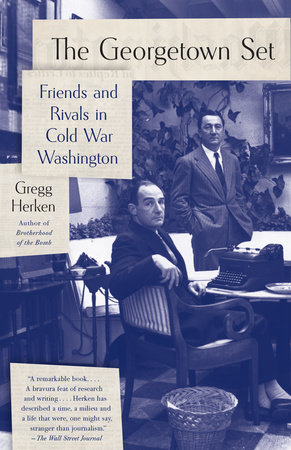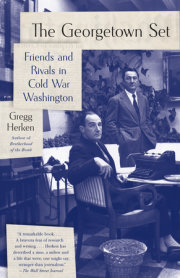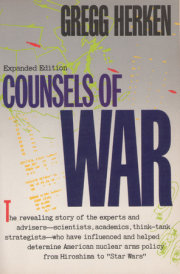CHAPTER ONE
A Political Village
The war was over, and those who had been away for so long finally began to come home.
A thirty-four-year-old journalist, Joseph Alsop, was one of the first to arrive back in Washington. Joe returned in September 1945 to the small brick town house on Georgetowns Dumbarton Avenue where he had lived before the war. A U.S. Navy lieutenant, Alsop had been in Hong Kong when Pearl Harbor was attacked by the Japanese. Sent to an internment camp, he was repatriated to the States in a June 1942 prisoner exchange. But Alsop had quickly gone back to China, becoming an aide and adviser to General Claire Chennault, commander of the American Volunteer Groupthe famed Flying Tigers. There, Joe had deliberately inserted himself into the labyrinthine complexities of Sino-American affairs. He was literate, excitable and persuasive with just enough superficial acquaintance with the situation to be opinionated and to appear knowledgeable, the historian Barbara Tuchman, a noted China expert and Alsop critic, later wrote.
Joe had sided with Chennault in the latters protracted feud with the U.S. Army general Joseph Vinegar Joe Stilwell over Americas strategy in China. Chennault trusted in air power and in Nationalist Chinese leader Chiang Kai-shek, a U.S. ally, to defeat the Japanese. Stilwell believed Chiangwhom he derisively called the Peanutto be hopelessly corrupt, and planned to beat the enemy in a traditional ground offensive, using Chinese troops bolstered by American lend-lease aid. Alsops lobbying on behalf of Chennault ultimately played a role in President Franklin D. Roosevelts 1944 decision to recall Stilwell. Alsop returned from the war in Asia with a strong anti-Communist bias, an enduring belief that it was Americas duty to stand up for the underdog, and an impressive collection of Ming dynasty ceramics.
On his way home from China, Alsop had stopped off in Paris to visit his longtime friend and Harvard classmate Bill Patten. Bills wife, Susan Mary, recalled that Joes luggage contained lots of emeralds...and rare old Chinese bronzes for the Alsop collection.
The emeralds were for the wife of Joes younger brother Stewart, who had been kept out of the U.S. Army after Pearl Harbor by asthma and high blood pressure. Stew had instead joined Britains Kings Royal Rifle Corps, transferring in 1944 to Americas Office of Strategic Services, where he became a member of the legendary OSS Jedburghs, three-man commando teams who had parachuted into Nazi-occupied France to aid the Resistance. At wars end, he was awarded the Croix de Guerre with Palm by the French government for his work with the partisans. Stewart was preparing for similar Jedburgh missions in Thailand when Japan surrendered.
Uninterested in the prospect of returning to his prewar desk job as an editor at Doubleday after his derring-do with the OSS, Stew had filled out an application for the Foreign Service before deciding to throw in his lot with Joe, as co-author of a syndicated political column for the New York Herald Tribune. The man who would be described as the kinder, gentler Alsop, and a more human version of his older brother, added a needed perspective and more moderate temperament to the column they dubbed Matter of Fact. Their four-times-a-week column, Stewart boasted, would be essential reading for those who want, not only the news-behind-the news but the news-before-the news. Both Alsops would also write longer pieces for The Saturday Evening Post, with which Joe had a long-standing relationship.
Stewart and his British-born wife, Patricia HankeyTishtemporarily moved in with relatives but later bought a house on Dumbarton, just down the block from Joe. The first installment of the brothers newspaper column would appear on the last day of 195.
like stewart alsop, the attorney Frank Gardiner Wisner, thirty-six, had spent the war overseas in the OSS and had just as little interest in returning to his prewar job. Enlisting in the navy six months before Pearl Harbor, Wisner had transferred into the countrys fledgling intelligence service shortly after fighting began. Stationed first in Egypt, then in Turkey, he later became the OSS station chief in Bucharest, Romania. In 1944, Wisners official task had been to help rescue downed American fliers. But his first priority was keeping tabs on the Soviets in the Romanian capital, as the Red Army pushed the German Wehrmacht out of Eastern Europe.
Wisners apprehensions about Soviet intentions had grown in step with the Russian advance. The final shock had come in early winter 1945, when Frank watched helplessly as the Russians filled more than two dozen unheated boxcars with thousands of ethnic Germansmen, women, and childrenand shipped the families to an uncertain fate as slave laborers in the east. (Like a modern-day Paul Revere, Wisner had driven frantically around the Romanian capital in his jeep, trying to warn the Volksdeutschebut he was too late.) Until then, Wisner wrote in his final OSS report from Bucharest, the Soviets had been fairly careful to avoid giving the appearance of taking over the country. Frank finished out the war in U.S.-occupied Germany, keeping an eye on the Russians just across the border. With characteristic impatience, Wisner secretly sent three OSS operatives through Soviet lines to recruit new agents for a postwar spy network; the ink had barely dried on the German surrender document when Frank had his first report on life in Russian-occupied Berlin.
Temporarily at a loss as to what to do in a world at peace, Wisner reluctantly went back to his prewar job at the Wall Street law firm of Carter Ledyard in early 1946. But he had recently told his wife, Polly, that he was bored with being an attorney and tired of living in New York City. Wisner had discovered that his time as a wartime spy chiefquartered in the requisitioned thirty-room mansion of a Bucharest beer magnate, with a fleet of captured Mercedes in the courtyard and a young Romanian princess serving as his self-described hostessstill held a siren-like appeal. Anticipating a move to Washington in the near future, Frank purchased a three-hundred-acre farm in rural Maryland.
thirty-year-old Philip Graham returned to a Washington very much changed by the war. The parochial town said to have a reputation for northern charm and southern efficiency had suddenly become the capital of the Free World. A magna cum laude graduate of Harvard Law, class of 1939, Graham had clerked for the Supreme Court justice Felix Frankfurter following law school. But the brilliant political career that most assumed lay ahead of Phil was first postponed, and then forgotten, after he married his future bosss daughter, Katharine Meyer, in 1940.
As only his wife and close friends at the time knew, Grahams confident and charming demeanor masked a carefully hidden secret. Beginning with his undergraduate years at the University of Florida, Phil had shown signs of the sudden and radical mood swings that would characterize his later life: periods of almost-maniacal and incandescent energy alternated with bouts of deep, incapacitating depression.
Shortly before Pearl Harbor, Phil had joined the Office of Emergency Management, which was readying the country for the coming conflict. In 1942, he enlisted in the Army Air Forces as a private, ending the war as a major on the AAF intelligence staff in the Philippines. He had originally signed up with the more prestigious OSS but after two weeks decided that he had had enough of what he called the white-shoe boys and requested reassignment to a bombardment squadron, or similar duties.
By April 1945, Katharine GrahamKayhad given birth to the couples second child and moved the family into a new home at Georgetowns Thirty-Third and O Streets. A dozen years earlier, Kays father, Eugene Meyer, had bought a struggling newspaper, The Washington Post, at a bankruptcy sale. Meyer had extracted a promise from Phil that the son-in-law would take over the paper when he returned from the war.
Having previously worked as a reporter on a San Francisco newspaper, Kay gave up her job on the Washington Post circulation desk to devote her full time to the children and Phil, who became the new associate publisher of the paper on January 1, 1946. Along with the Herald Tribune, the Post was one of the major urban dailies subscribing to the syndicate that would publish Matter of Fact. The previous day, in small type at the bottom of the front page, the Post had announced, Joseph Alsop and his brother Stewart begin their new column today on page 9.
For the Alsops, the Wisners, and the Grahams, it was the beginning of a long, tumultuous, and consequential friendship.
Copyright © 2014 by Gregg Herken. All rights reserved. No part of this excerpt may be reproduced or reprinted without permission in writing from the publisher.





